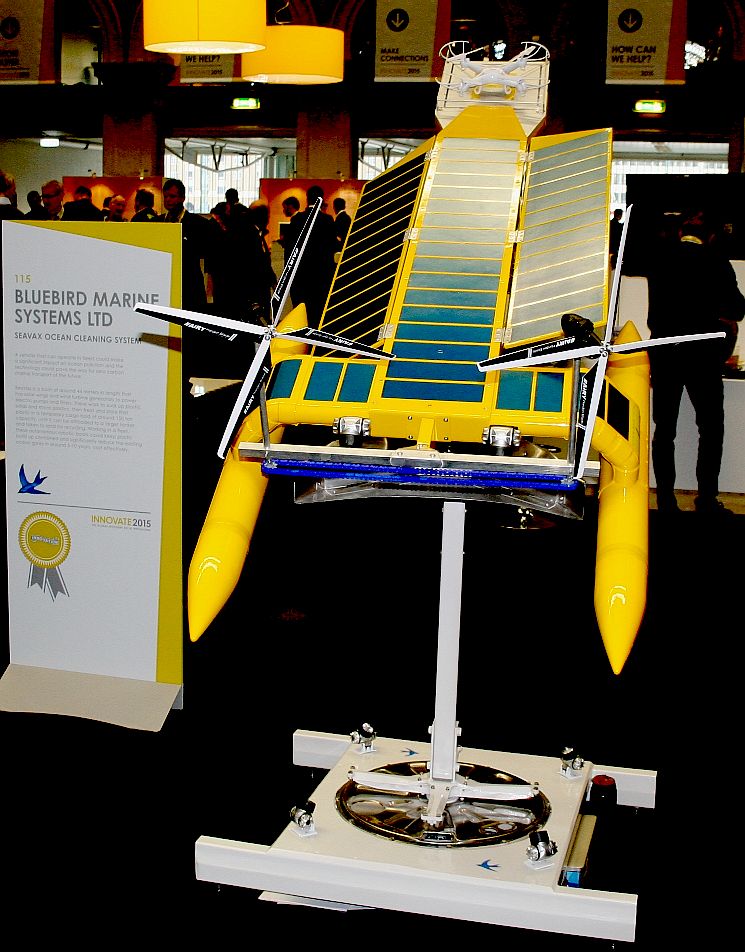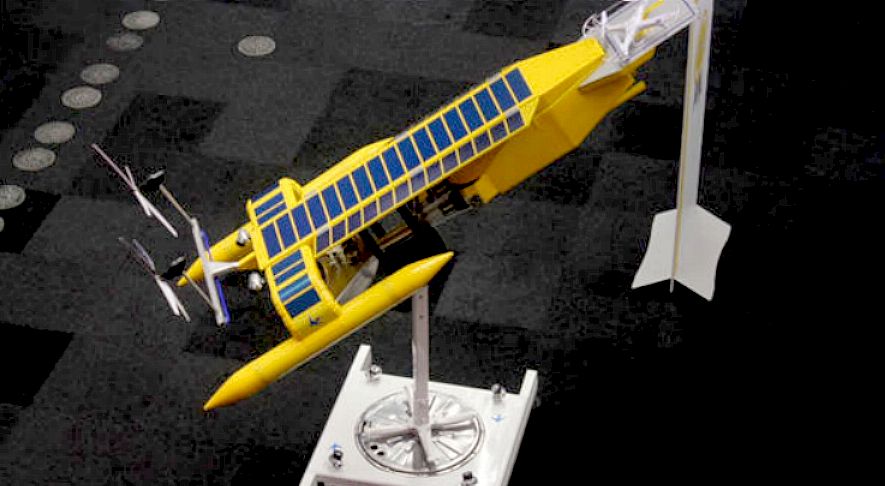|
5 GYRES 19 FEBRUARY 2016
INNOVATION - This amazing autonomous boat was on display at the Old Billingsgate exhibition centre in London on the 9-10th of November 2015. The stand was especially made for this show. As you can see it is possible to tilt the robot vessel so that it is almost vertical. The stand is motorised to revolve at about one revolution in half a minute. Although not ready for this year's outing, it is planned to make the stand interactive with audiences and to fit driven wheels such that the robotic boat and stand combined can give interesting displays, demonstrating the versatility of robotics. The boat is designed to vacuum plastic waste from the polluted oceans and rivers (RiverVax) of the world. Not at this scale. This proof of concept model is only 2.2 metres long. The full size vessel is 44 metres long with a suction head some 13.5 metres wide (44 feet) - making it the world's largest vacuum cleaner.
SEAVAX
: TECHNO-FIX TO PLASTIC POLLUTION?
SEAVAX - Has passed proof of concept stage. Many people do not realise that the scale model above is fully functional and the subject of ongoing development. Working smaller than full size can yield results more quickly. The RiverVax version of SeaVax is presently being looked at. This might please those commenting, where we are alive to the issues - or we'd not be able to design the cleanup machine. From inception, river work has been high on the agenda. Unfortunately, we cannot elaborate on design issues more than to say that is the case, where patent law prohibits publication of new art, before application. This would invalidate the intellectual property that Bluebird Marine Systems are developing with the benefit of significant personal investment. At this time they are funded by directors loans - and we are told that under European rules, they do not qualify for Horizon 2020 or any other kind of Dti incentives.
They will though undertake paid development from governments and other organizations, such as the World Health Organization, World Bank, United Nations and others - in the form of contracts. At the time of writing, we understand that only one government in the East is showing some interest.
LINKS & REFERENCE
https://ecowatch.com/2016/02/19/seavax-vacuum-ocean-plastic/ 5gyres blog posts 2016 gyres_in_india_contrasts_of_rich_and_poor_where_does_the_plastic_pollution_go http://www.5gyres.org/blog/posts/2014/04/17/5_gyres_in_india_contrasts_of_rich_and_poor_where_does_the_plastic_pollution_go http://www.5gyres.org/blog/posts/2016/2/19/8yv315b47fhng8gs8guka4p742d8y2 http://www.bluebird-electric.net/oceanography/Ocean_Plastic_International_Rescue/SeaVax_Ocean_Clean_Up_Robot_Drone_Ship_Sea_Vacuum.htm http://theterramarproject.org/thedailycatch/prototype-for-robotic-boat-suck-plastic-waste-unveiled-innovate-uk/ https://ecowatch.com/2016/02/19/seavax-vacuum-ocean-plastic/ http://www.energymatters.com.au/renewable-news/solar-wind-seavax-em5350/ http://www.csiro.au/en/News/News-releases/2015/Marine-debris http://www.express.co.uk/search/Maisha+Frost%252C+Exclusive?s=Maisha+Frost%2C+Exclusive&b=1 http://www.express.co.uk/finance/city/638166/New-cleaner-SeaVax-has-solution-to-ocean-plastic-waste http://www.plasticsoupfoundation.org/
|
|
|
This webpage is copyright © Cleaner Oceans Club Ltd (Company No: 4674774) February 2016, Solar Studios, BN271RF, United Kingdom. The name Miss Ocean™ is a trademark of the Cleaner Oceans Club™.
|


